Summary
Introduction
The share of people with foreign background in Finland's population has risen from 0.8 to 5.9 per cent between 1990 and 2014. In 2014, there were 241,000 persons aged 15 to 64 living permanently in Finland, whose both parents were born abroad. Persons with foreign background are a heterogeneous population group who have very different backgrounds. This group includes both Europeans having moved to Finland for work and refuges running away from war on other continents. The results of the survey on work and well-being among persons of foreign origin (UTH) describe comprehensively the reasons for immigration, education, language skills and labour market situation, health, well-being and supply of services for the population with foreign background living in Finland in 2014. Many topics were now explored for the first time at this accuracy and scope in this survey with an extensive information content.
In a new country and different cultural environment, human and social capital do not necessarily correspond to the situation to which a person who moved here has accustomed in his or her home country. The survey aimed to increase knowledge about Finland's population with foreign background to advance integration. These data can be utilised in a versatile manner to develop various services. This summary describes the results presented in the report on the most important topics. The survey data also provide diverse possibilities for more detailed studies on various subjects. A service dataset has been formed of the data which can be applied for research use.
Reason for immigration: Over one-half of Finland's population with foreign background moved to the country for family reasons
The survey on work and well-being among persons of foreign origin (UTH) for the first time provided information on the reasons for immigration for the entire population with foreign background. The survey indicated that family reasons – family, marriage, love or a personal relationship – were by far the most important reasons (54%) for coming here among those living in Finland in 2014 who had moved from abroad. Every fourth of those having moved for family reasons had come to the country as a child aged under 15 with their parents. Based on the immigrants' background country, it can be estimated that around one in ten of those having moved for family reasons had come here through family reunification for refugees.
Work had been the primary reason for moving to Finland for nearly one fifth, every tenth gave studying as the most important reason, every tenth had moved because of being a refugee and eight per cent had primarily some other reason for moving here. Men had moved more commonly because of work or studying than women, for whom family reasons were more often the reason behind moving than for men. More of men also had a refugee background.
Figure 1
Main reason for immigration among population aged 15 to 64 with foreign background born abroad by gender in 2014, (%)
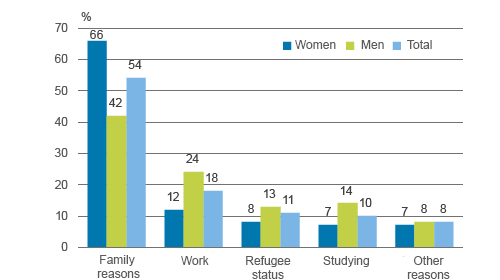
Source: UTH survey, Statistics Finland
Previously, the information on the reasons for immigration was based on the statistics on residence permits granted by the Finnish Immigration Service (Migri). The picture becomes more versatile when the information is calculated from the UTH data, which represent the entire population with foreign background living in the country and which asked for a person’s own view on their reasons for immigration. Table 6 describes the personal reasons for coming to Finland reported by persons with foreign background living in Finland in 2014 by citizenship (UTH data). The table also shows on which grounds the Finnish Immigration Service granted residence permits for citizens of countries outside the EU and EFTA in 2013.
The population with foreign background includes many more (54%) of those who have moved for family reasons than can be estimated based on statistics on residence permits only (32%). According to the UTH survey, there are considerably fewer (17%) of those who have moved for work-related reasons than in the Migri statistics (25%). Thus, the UTH data cover the entire population aged 15 to 64 with foreign background, but the Migri data represent all-age citizens of countries outside the EU and EFTA. As can be seen from Table 6, the data of different statistics also differ for third-country citizens.
Table 6
Main reason for immigration (own report) among population aged 15 to 64 with foreign background born abroad by citizenship in 2014 (UTH), (%) and residence permits granted by Migri in 2013.
|
|
Total UTH 2014 |
Finnish citizen UTH 2014 |
EU/EFTA country citizen UTH 2014 |
Third-country citizen UTH 2014 |
Residence permits granted 2013 Migri |
|---|---|---|---|---|---|
|
Family reasons |
54 |
67 |
47 |
49 |
33 |
|
Work |
17 |
7 |
36 |
14 |
26 |
|
Refugee status |
11 |
13 |
0 |
15 |
9 |
|
Studies |
10 |
4 |
7 |
16 |
28 |
|
Other reason |
8 |
8 |
9 |
6 |
3 |
|
Total |
100 |
100 |
100 |
100 |
100 |
Source: UTH survey, Statistics Finland, Migri 2015
Differences in data from different sources are caused by the different definition of the concept and by the time. Migri's figures given here describe residence permits granted quite recently in 2013, while some of the respondents in the UTH data have come to Finland already decades ago. For this reason, it is natural that the UTH data included considerably fewer third-country citizens (16%) who had come to the country for studying than third-country citizens who had been granted a residence permit based on studies (28%) in 2013: many of those who have been granted a residence permit for studying move away after the studies end and in a couple of years they are no longer included in the resident population (Garam et al. 2014)
Differences between register data and UTH survey results are also explained by that in the UTH survey respondents were asked for their personal reason for coming to Finland, but granting a residence permit is based on legal issues. The respondent's personal reason for moving to Finland may have been other than the one on which grounds the residence permit had been granted: those having come to Finland for love have, for example, acquired a job to get a residence permit and to carry on their personal relationship. At the same time, they feel that the actual reason for moving to the country was just this personal relationship.
The reason for immigration is used as a background variable when viewing many areas of life in this publication, because depending on the reason for immigration, the immigrants' bases for settling in the country very much. Other background variables are such as background country, level of education, age of immigration, duration of living in the country, age and gender.
Education: Many persons with high and low level of education among persons with foreign background
For the first time, the results of the UTH survey offer comprehensive information on the educational level of the population with foreign background living in Finland. Previous information on the educational background of persons with foreign background has been based on the data of the Register of Completed Education and Degrees, from which most of the qualifications taken by persons with foreign background are missing. If a person has no qualification in the Register of Completed Education and Degrees, there is no way of knowing whether this is caused by that no qualification has been taken or that the existing qualification is not entered in the register. The person is then classified under "basic level education/ unknown". Over one-half (87,000) of persons aged 25 to 54 with foreign background living in Finland in 2013 belonged to the group with low education and unknown education (Figure 3). According to the Register of Completed Education and Degrees data, only 24 per cent (41,000) of those aged 25 to 54 had upper secondary level and 25 per cent (42,000) tertiary level education.
The UTH survey data show that there is strong undercoverage in the number of upper secondary and tertiary level qualifications in the Register of Completed Education and Degrees. The shares and numbers of persons aged 25 to 54 with foreign background having completed upper secondary level qualifications (75,000) and tertiary level qualifications (71,000) nearly double when the data of the register are supplemented with interview data. The educational level of persons with foreign background is thus considerably better than could be deduced earlier based on inadequate register data.
Figure 3
Educational structure of population aged 25 to 54 with foreign background according to the Register of Completed Education and Degrees (2013) and the UTH survey (2014), %
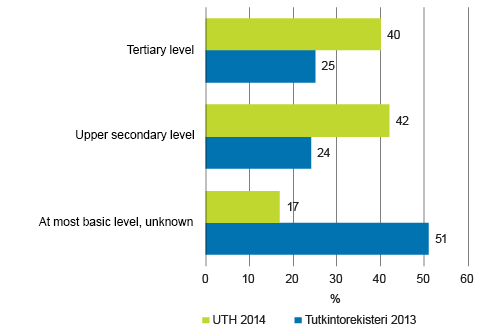
Source: UTH survey and the Register of Completed Education and Degrees, Statistics Finland
In comparison to persons with Finnish background, the educational structure of persons with foreign background is more polarised. According to the UTH survey, 40 per cent of the persons aged 25 to 54 with foreign background living in Finland had completed a tertiary level qualification, which is more or less the same share as in the same-age population with Finnish background (44%). On the other hand, the educational level of every sixth (17%) person aged 25 to 54 with foreign background was at most on the level corresponding to lower secondary level (comprehensive school or similar), while this was so for seven per cent among persons with Finnish background. A couple of per cent had gone to school for at most a few years, if even that, so there is a great need for organising basic education for adult immigrants. Upper secondary level qualifications were less common for persons with foreign background that for those with Finnish background. Investing in vocational education for the adult population without post-basic level education would be important to improve the employment capacity of this group.
Figure 2
Educational structure of population aged 25 to 54 with foreign and Finnish background living in Finland by gender in 2014, % (excl. education unknown)
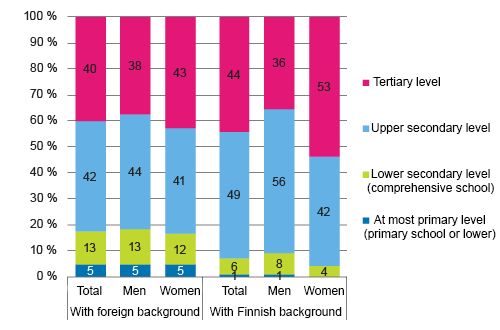
Source: UTH survey, Statistics Finland
Young people: Young people of foreign background continue to upper secondary education less often than those of Finnish background
The relatively large share of the population with low education among persons with foreign background is significant not only with regard to their employment possibilities, but also because education is inherited from parents to children. Among young people with foreign background, the share of those aged 18 to 24 among early leavers from education was 14 per cent in 2014, while among those with Finnish background this share was six per cent. Early leavers from education refer to those aged 18 to 24 who have no qualification after lower secondary education (comprehensive school) and who were not studying in education leading to a qualification or degree at the time of the survey. However, there is no difference in the share of early leavers from education between persons with foreign background and Finnish background, when comparing young people whose parents had taken a tertiary level or upper secondary level qualification (see Figure 5). For young people whose parents have completed at most lower secondary level education, the difference did not, in turn, disappear. The educational background of parents thus explains part of the differences of young people with Finnish and foreign background in the generality of early leaving from education. The inheritance of education has particularly much effect on the educational structure of young adults with foreign background, because 29 per cent of their parents had completed at most lower secondary education, while this was so for six per cent of parents of young people with Finnish background. In addition to young people, it is thus probably necessary to support their parents so that they could better help their young in schooling and encourage continuing in education.
The reason for early leaving from education was mostly the desire to move on to working life (31% of persons not studying aged 15 to 29), but early exit to working life may backfire later, because there are ever fewer jobs based on basic level education. For young women with foreign background, early family formation also hinders starting of studies and work. Participation of young mothers in education and training should be supported by easing arrangement of studies and childcare, for example.
The share of young people aged 15 to 29 with foreign background outside education and work, that is, the so-called NEET rate (Not in Employment, Education or Training) was also slightly bigger (15%) than among young with Finnish background (11%). If parents' educational background is taken into consideration, differences between young people with foreign and Finnish background disappear, however: around every fifth young person, whose both parents had at most basic level education, was outside work and education despite his or her origin, but only around every tenth among children of parents with high education.
Figure 5
Indicators related to education of young people with foreign and Finnish background according to parents' educational background in 2014, %
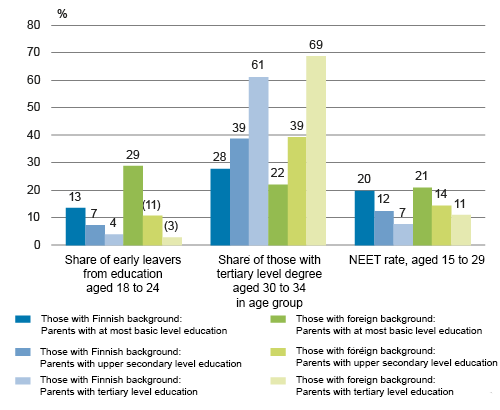
( ) = The information in brackets is unreliable due to the small number of observations
Source: UTH survey 2014, Statistics Finland
Although first-generation immigrants coming to Finland at under school age appeared to fare well according to many survey indicators, difficulties accumulated especially for those moving to Finland at school age. For example, the later employment rate of those having moved at school age was clearly lower than among those who moved at under school age or at the age of 20 to 29. Early leaving from school was connected to weaker language skills among young people with foreign background. Every tenth early leaver from education also reported their weak language skills as the reason for leaving school – however, the common reasons were wanting to work rather than study and being without a student place they had applied for. It appears that more support than at present would be particularly needed for the integration of children and young people who came to the country at school age and for strengthening their language skills to a level required by further studies.
Language skills: Three out of four persons with foreign background have at least average level of Finnish or Swedish language skills
The UTH survey also for the first time gave information on the language skills of the entire population with foreign background. Nearly every fifth of first-generation immigrants with foreign background thought their skills in Finnish or Swedish were at the same level as their native language, every fourth considered their level advanced and nearly every third average. One in four thought, however, that they knew only elementary Finnish or Swedish. Around two per cent of first-generation immigrants with foreign background did not speak any Finnish, Swedish or English. Finnish and Swedish skills were best for young people, and they improved as a result of living in the country. Three out of four persons with foreign background assessed they had received enough integration services (language courses, employment courses, preparatory courses for immigrants and other courses related to immigration) or felt they did not need them. However, every fourth considered integration services insufficient: more of these services would have been needed particularly by those having moved to Finland a short while ago, those aged 25 to 34, those having come here to study, and those with African background.
The survey results show that the significance of language skills to education and employment is in a key position. Poor proficiency in Finnish and Swedish is connected to early leaving from education and unemployment; non-employed persons with foreign background most commonly stated poor language skills as an obstacle to their finding employment. The employment rate of those knowing Finnish or Swedish at advanced level was on level with those with Finnish background in 2014; the employment rate of those speaking Finnish or Swedish at native level was even slightly higher than among persons with Finnish background.
Employment: Employment rate of men with foreign background nearly on level with men with Finnish background – women have more difficulties in finding work
The register-based employment data widely used in Finland have given an unnecessarily dismal picture of the employment of people with foreign background. In the UTH survey, measured by international standards (ILO, LFS), the employment rate of people with foreign background aged 20 to 64 was in all around ten percentage points lower (64%) than among persons with Finnish background (74%) in 2014 (Figure 1), while according to the register-based employment statistics, the difference was nearly 19 percentage points (2013). The difference between the UTH survey made as an interview survey and the register-based employment figures of employment statistics appears to be explained by that the employment relationships of persons with foreign background are more often part-time and fixed-term, and some of these short employment relationships are excluded from the definitions of the statistics based on register sources.
Figure 1
Employment rate by gender and origin, population aged 20 to 64 in Finland in 2014, %
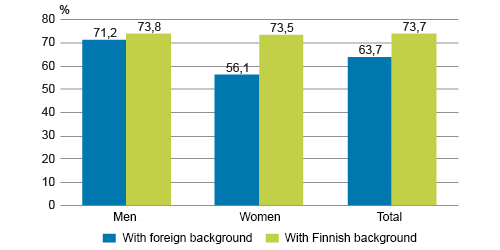
Source: UTH survey 2014, Statistics Finland
The lower employment rate of the population with foreign background compared with persons with Finnish background is particularly connected to the low employment of women with foreign background (56%) compared with women with Finnish background (73%) (Figure 1). The employment rate of men with foreign background was only a few percentage points lower (71%) than that of men with Finnish background (74%). The duration of living in the country is another significant explanatory factor, but the growth in employment along with the duration of living in Finland is visible most of all as increased employment for women in time. Forty per cent of women with foreign background having lived in Finland for under five years were employed in 2014, but as many as 67 per cent of those having lived here for over ten years.
The employment rate also varies by the reason for immigration and background country. The employment rate of work-related immigrants is understandably high, even higher than for persons with Finnish background. In turn, finding employment takes longer for those with refugee background – during the first five years employment was still very low, but the employment rate of persons with refugee background having stayed from five to ten years in the country was already 30 per cent in 2014, and one -half of those with refugee background having been in Finland over ten years had found employment – 57 per cent of men. The challenges related to the employment of people with refugee background are connected to such as education and language skills, which are on average weaker than in other groups, and problems with mental wellbeing and work capacity and capability, which is more common for persons with refugee background than other groups.
The background country may be overlapping
with the reason for immigration: persons with EU, EFTA and North American background found employed best in 2014, as among them particularly many had come here for work. Employment was weakest among those with Middle East and African background, among whom the highest number had immigrated because of their refugee status.
The low employment rate (56%) of women with foreign background is partly connected to their early family formation and child home care. The employment of women with foreign background relative to women with Finnish background begins to weaken already in the 20 to 24 age group, where 15 per cent of women said childcare was their principal activity in 2014, while the corresponding share for women with Finnish background was four per cent. The employment of women with foreign background rises to its highest for those aged 44 to 49, although even then it stays below the employment of women with Finnish background.
Information has not previously been available on the employment of people with foreign background by level of education, because the Register of Completed Education and Degrees does not include the majority of qualifications taken abroad. The educational background had a significant effect on employment for permanent residents of Finland aged 20 to 64 with both foreign and Finnish background in 2014. Those having completed a tertiary level qualification found employment most easily and those with at most basic level education least easily. Figure 6 indicates that if men educated in the same way are compared, the difference in the employment rate between men with foreign and Finnish background becomes very small; men with foreign background having completed at most basic level education find employment even slightly better than men with Finnish background. Women's education does not even out the differences, however, as the employment rate of women with foreign background was weaker than that of women with Finnish background in all levels of education.
The weak employment of those with at most basic level education influences the employment rate of persons with foreign background more than that of people with Finnish background. This is caused by that nearly double the number of persons aged 20 to 64 with foreign background (18%) had completed at most basic level education compared with persons with Finnish background (10%) in 2014.
Figure 6
Employment rate by level of education, gender and origin, population aged 20 to 64 in 2014, %
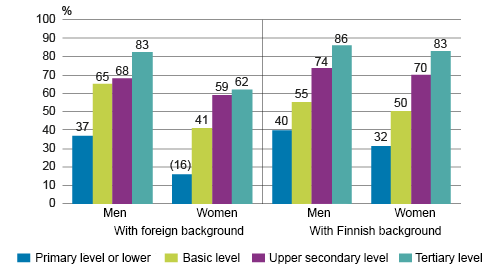
( ) = The information in brackets is unreliable due to the small number of observations
Source: UTH survey 2014, Statistics Finland
In working life: Persons with foreign background in working life
Persons with foreign background formed around six per cent (144,000) of all employed persons aged 15 to 64 in 2014. Persons with foreign background in working life worked as entrepreneurs more or less as often as persons with Finnish background, but in slightly different fields. If agriculture and forestry are not taken into account, entrepreneurship was more common for persons with foreign background (14%) than for those with Finnish background (11%). Although the average weekly working hours of wage and salary earners with foreign and Finnish background were fairly similar in 2014, entrepreneurs with foreign background worked a longer week than entrepreneurs with Finnish background.
All in all, employed persons aged 15 to 64 with foreign background living in Finland in 2014 were employed largely in the same occupational fields as employed persons with Finnish background. However, the difference was that persons with foreign background were employed less often in expert occupations than those with Finnish background and that compared to persons with Finnish background, those with foreign background were to some extent over-represented in service and sales work as well as in other worker occupations. In this respect, a connection can be seen between the occupational structure of persons aged 15 to 64 with foreign background and the occupational structure of persons aged 15 to 24 with Finnish background entering the labour market.
These certain similarities in the occupational structure of those with foreign background and those entering the labour market in general are reflected in that similar features are emphasised in modes of work by employed persons with foreign background as by young employed persons. For example, fixed-term and part-time employment relationships were relatively common for wage and salary earners with foreign background in others than just the youngest age groups in 2014 (Figure 9), as are atypical working hours and shift work. However, the occupational structure does not explain that every tenth employed person with foreign background was under-employed (an employed person who would like to work more) in 2014, which figure is double compared with those with Finnish background. People with foreign background also did shift work on the whole more commonly than persons with Finnish background.
Figure 9
Share of part-time working among employed persons aged 15 to 64 with foreign background and Finnish background by gender and age in 2014, %
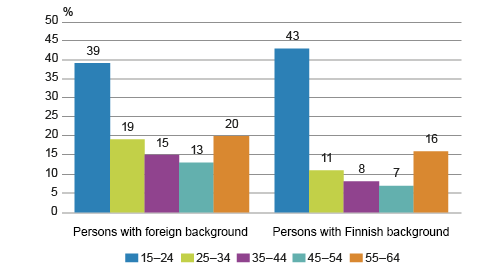
( ) = The information in brackets is unreliable due to the small number of observations
Source: UTH survey 2014, Statistics Finland
When examining transition to work, the position of tertiary level educated persons in working life is noteworthy. The employment rate of tertiary level educated persons with foreign background is indeed better than that of persons with lower education. But while many features of work for people with Finnish background and foreign background who had completed at most lower secondary or upper secondary level education resembled each other, the situation was somewhat different for those having completed tertiary level education. Every fifth employed person with foreign background having completed tertiary level education worked in worker occupations, while the corresponding share for those with Finnish background was only a few per cent. Highly educated people with foreign background experienced considerably more often underemployment, worked clearly more commonly in fixed-term and part-time jobs, and their working times were more often atypical than among persons with Finnish background. The results of the survey raise the question to what degree the existing competence capacity of particularly highly-educated people with foreign background is so far being utilised and appreciated in Finnish working life.
In 2014, over one-half of wage and salary earners with foreign background were working in jobs where at least one quarter of employees were of immigrant background. The overwhelming majority of wage and salary earners with foreign background felt that the treatment of people with foreign background was equal at the workplace and they thought they received support from their co-workers and supervisors similarly as other wage and salary earners. Differences between background countries became evident, however: a significant group of those with Middle Eastern and African background were left outside support and help from co-workers and they did not feel their treatment at the workplace was equal as often as other groups.
Unemployment: Job search of non-employed persons with foreign background is more active than among those with Finnish background – lack of language skills the biggest obstacle to employment
Unemployment and long-term unemployment were more common for those with foreign background than for persons with Finnish background, as was being in the inactive population in 2014. The unemployment rate of men aged 20 to 64 with foreign background was 14.4 per cent and that of women 17.0 per cent in 2014 (Figure 2). The unemployment rate of men with Finnish background was 8.4 per cent and that of women 6.3 per cent. The unemployment rate was the lower the higher the person was educated among both those with Finnish and foreign background, but the educational background did not fully explain the differences between these groups.
Figure 2
Unemployment rate of population aged 20 to 64 with foreign and Finnish background by gender and level of education in 2014, %
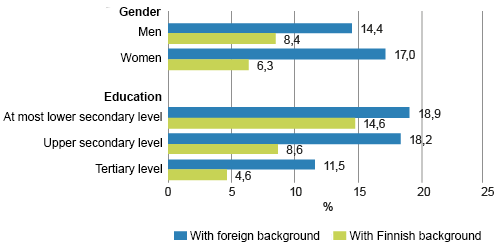
Source: UTH survey 2014, Statistics Finland
Unemployed persons with foreign background had searched for work more actively, on average, than those with Finnish background, and they had utilised various ways of looking for work. Social networks and answering to job advertisements appeared to advance employment most. Of the inactive population with foreign background, more would have been willing and ready to take a job than among the inactive population with Finnish background.
Forty per cent of non-employed persons aged 20 to 64 with foreign background living permanently in Finland in 2014 considered their lack of Finnish or Swedish skills the main obstacle to employment. Only six per cent of non-employed persons with foreign background named their foreign background, religion or social background as the main problem for employment. It is positive that 24 per cent of non-employed persons with foreign background did not see any special obstacle related to their foreign background to their employment.
Mental well-being, security and involvement
The experience of persons with foreign background on security is built on mental well-being, involvement and trust and the possibility to receive help in everyday situations. Mental stress was not more common for persons with foreign background than for the whole population of Finland. However, persons of Middle Eastern and North African origin had more often mental stress and more mental health problems diagnosed by a doctor than in the whole population of Finland or other groups with foreign background, and more use of depressants, sleeping medicine or tranquilisers than in other groups with foreign background. Traumatic experiences are common for those with refugee background, of whom three out of four had experienced some shocking event in their former home country. Persons with foreign background told they had experienced violent situations during the past 12 months less often, on average, than the whole population of Finland, men more commonly than women. Discrimination (unfair treatment) when dealing with the police, the Social Insurance Institution of Finland, the social service office, health care services or the Employment and Economic Development Offices had been experienced by 10 to 13 per cent of persons with foreign background.
For young adults, those born in Finland or those having moved to Finland at under school age appeared to have more experiences of insecurity than older people and those having moved to Finland as adults and those having lived here a longer time. Compared with older age groups, young adults had less often Finnish friends, they believed less commonly they could get help from their neighbours, their trust in people was weaker and they had more often met with violence and unfair treatment from strangers. Particularly persons with refugee background had had most experiences related to insecurity and work-related immigrants had had them least. Persons with foreign background living in Greater Helsinki had more experiences related to insecurity than those living elsewhere in Finland.
The situation of young adults, second-generation immigrants and persons with refugee background should receive particular attention. Various school, friend and resident activity projects can be important in fortifying social relations and strengthening experiences of security. In Finland, measures are particularly needed for enhancing the mental well-being of the population with foreign background.
Life style, health and functional capacity
For persons with foreign background many life style aspects can be similar to those in their country of departure. On the other hand, differing availability of foodstuffs can change their previous eating habits and the colder climate their customary physical activities. In particular, alcohol use was considerably lower among persons with foreign background than in the whole population of Finland: many were total abstainers and only a few drank a lot of alcohol. Life style choices were more health promoting among many groups of foreign background than among the entire Finnish population. An exception to this was the low level of fitness training of women with Middle Eastern and North African and other African background, the generality of smoking by men in all groups with foreign background, and the lower eating of fruit and vegetables by men in the Other Africa group and men with Russian background. Men with Russian, Estonian and Asian background and men belonging to the Middle Eastern and North African groups smoke more often (30% to 42%) than men in the entire Finnish population (19%). There were more persons who use a lot of alcohol among persons with Russian and Estonian background than in other groups with foreign background.
Overweight and obesity are significant risk factors for chronic illnesses and weakening of physical capacity, to which lifestyle is hugely important. Overweight and obesity were rarer in the whole group with foreign background (47% and 14%) than in the entire Finnish population (54% and 15%). However, obesity was most common for women in the other Africa group (23%) and women in the Middle East and North Africa group (21%).
Persons with foreign background felt their health was better, on average, than the entire population of Finland. However, women with foreign background considered their health worse and they reported chronic illnesses or health problems more often than men. Chronic illnesses or health problems were most common for those with Middle Eastern and North African background. Mobility and visual difficulties are more common, on average, for people with foreign background than in the entire population of Finland, but persons with foreign background thought their health problems restricted their ordinary activity less often than the whole population. The share of those who felt their working capacity had weakened was clearly higher among those with foreign background than in the whole population. Mobility limitations and problems in working capacity particularly concerned persons whose background country was in the Middle East and North Africa.
Supply of services
People with foreign background reported less often unsatisfied needs for services than the Finnish population. The share of persons with foreign background who thought they had received insufficient social and health care services varied again by background country. The experienced need for the services of a health centre doctor and social worker was more common among persons with foreign background than in the whole population. The results indicate that the use of health care services by persons with foreign background does not fully correspond to the service need based on symptoms and sickness rate, particularly for mental health care services. People with foreign background have also used less oral health care services although they reported a need for such services more often than the whole population.
Children with foreign background were fairly fully in the scope of day care services. However, the day care of the youngest child only was examined in this survey. In future, the realisation of early education should be examined more closely in those age groups where the significance of pre-primary education and day care is greatest for developing school readiness.
Subsistence, quality of life and personal relationships
Living in an owner-occupied dwelling was considerably rarer for those with foreign background (39%) than for the entire Finnish population (68%). Owner-occupancy was least common for those from the Middle East, Africa and Estonia. People from the Middle East and Africa had also most often feared running out of food. In turn, fewer of those with foreign background had had to go without medicines or doctor's visits than the entire Finnish population.
A slightly smaller share of persons with foreign background (74%) felt their quality of life was good compared to the whole population of Finland (78%). In the group of people originating from the Middle East and North Africa, clearly fewer felt their quality of life was good (58%) than in other groups with foreign background or the entire population of Finland. Those from the Middle East and North Africa were also more worried than others about coping with everyday activities. On the other hand, persons with foreign background were more satisfied with their personal relationships, also those from the Middle East and North Africa, than the entire Finnish population.
